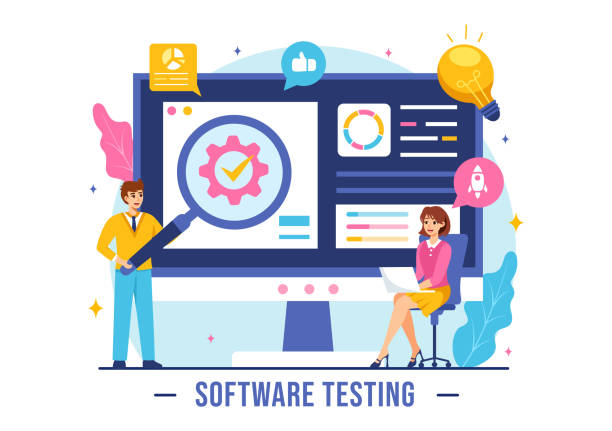An Introduction to Responsive Website Design: Why is it Important Now?

In today’s world, where technology advances at the speed of light, #responsive_website_design is no longer a luxury option but a vital necessity.
This web design approach allows websites to automatically adapt to any screen size and device a user employs (whether it’s a mobile phone, tablet, laptop, or smart TV).
This means providing a seamless and optimized user experience for all users, regardless of their device.
There’s no longer a need to develop separate versions for mobile and desktop, as a single website with responsive website design can meet the needs of all users.
This approach reduces costs and optimizes development time.
With the increasing use of mobile devices for internet access, neglecting the importance of responsive web design can mean losing a significant portion of the audience.
A website that doesn’t display well on mobile quickly discourages users and will have a high bounce rate.
From an SEO perspective, Google and other search engines prioritize responsive websites, showing them higher in mobile search results.
This is very important news for businesses seeking online visibility.
Therefore, investing in responsive website design is crucial not only for customer satisfaction but also for success in online searches.
This is a comprehensive and explanatory approach to understanding the basic concept.
Are you tired of your company’s website not meeting your expectations? With Rasavweb, design a professional website that truly represents your business.
✅ Increase acquisition of new customers and sales leads
✅ Enhance your brand’s credibility and trust among your audience
⚡ Get a free website design consultation!
Unparalleled Advantages of Responsive Design: Why Adopt It?

#responsive_website_design is more than a technical feature; it’s a strategic investment for any online business.
One of its most significant advantages is improved user experience.
When a website automatically adapts to the user’s screen size, users don’t need to zoom, scroll horizontally, or struggle to find information.
This ease of use increases user satisfaction and gives them more incentive to stay on the site and interact with the content.
As a result, the conversion rate can significantly increase.
This is an important analysis from a user perspective, showing why a responsive site is of high importance.
In addition to user experience, #SEO also benefits from responsive website design.
Google has explicitly stated that it prefers responsive websites and ranks them as mobile-friendly websites.
This means higher rankings in mobile search results, which translates to #more_traffic and #better_visibility.
Having a single website for all devices significantly simplifies content management and site maintenance.
There’s no longer a need to update two separate versions, which itself leads to cost reduction and #time_saving.
This approach guides how a technical decision can bring strategic results for a business.
Ultimately, a responsive site provides future flexibility and prepares your site for new devices that have not yet been introduced.
Key Principles of Responsive Design: The Foundation of a Flexible Website

#responsive_web_design is built on three main pillars, understanding which is essential for every web developer and designer.
The first pillar is #Fluid_Grids or flexible grids.
Instead of using fixed pixel units, this method uses relative units such as percentages for element widths.
This means that the website layout can fluidly resize to different screen dimensions.
This is a basic tutorial explaining how it works.
The second pillar is #Flexible_Images or scalable media.
Images and videos must also be able to resize proportionally to the available space on the screen to prevent overflow or excessive shrinkage.
This is typically done using CSS properties like `max-width: 100%`.
The third and perhaps most important pillar is #Media_Queries.
Media Queries are specific CSS rules that apply only when certain conditions (such as screen width, device orientation, and …) are met.
This allows the layout, fonts, and even the display of some elements to be customized for different screen sizes.
These three principles together form the skeleton of a responsive website design, enabling developers to provide flawless user experiences.
This section is completely specialized and explanatory, delving into the technical depth of the topic.
Below is a comparison between fixed design and responsive design presented in a table:
| Feature | Fixed Design | Responsive Design |
|---|---|---|
| Device Adaptability | Fixed, requires horizontal scrolling on small devices | Automatic, layout and content adapt to screen size |
| User Experience | Poor on different devices | Excellent and seamless on all devices |
| Management and Maintenance | Usually requires separate versions (e.g., mobile) | A single codebase for all devices |
| SEO (Search Engine Optimization) | May receive negative Google scores for mobile-friendliness | Positive score and better ranking in mobile searches |
| Cost and Development Time | May be higher for managing multiple versions | More optimized and faster with a single project |
Popular Tools and Frameworks for Responsive Design

To facilitate the #responsive_website_design process, numerous tools and frameworks have been developed to make work easier for designers and developers.
One of the most well-known and widely used is Bootstrap.
This front-end framework, by providing a comprehensive set of pre-designed CSS and JavaScript components, enables the quick and efficient creation of responsive websites.
Bootstrap features a 12-column grid system that helps you easily create responsive layouts.
Its use is a practical guide for starting projects.
In addition to Bootstrap, native CSS features like #Flexbox and #CSS_Grid have also revolutionized responsive website design.
Flexbox is ideal for one-dimensional layouts (row or column) and provides highly flexible space distribution and element alignment.
CSS Grid, however, is designed for two-dimensional layouts (simultaneous rows and columns) and offers unparalleled control over element placement on the page.
These two powerful features allow for the creation of complex and responsive layouts without the need for heavy frameworks.
This is a specialized and instructional section that refers to technical tools.
Other frameworks such as Foundation and Bulma are also popular options, each with its own specific features and advantages.
The choice of the right tool depends on project needs and developer preferences, but all ultimately pursue a single goal: ease of implementing responsive website design.
Did you know that customers’ first impression of your company is your website? With a powerful corporate website from Rasavweb, multiply your business’s credibility!
✅ Custom and captivating design tailored to your brand
✅ Improved user experience and increased customer attraction
⚡ Get a free consultation!
Challenges and Complexities of Responsive Design: Obstacles Ahead

Despite its numerous advantages, #responsive_website_design is not without challenges.
One of the biggest obstacles is Performance Management.
Responsive websites must load quickly not only on desktop devices but also on mobile devices with slower internet connections.
Using high-resolution images suitable for desktop can severely reduce loading speed on mobile.
This is a thought-provoking content that warns users about these challenges.
Another challenge is #design_and_testing_complexity.
Given that the website must function well across dozens of different screen sizes and orientations, the design and testing process becomes much more complex.
Designers must consider all possible scenarios, and developers must ensure that the code works correctly across all browsers and devices.
This requires advanced testing tools and comprehensive approaches.
Content management can also be a challenge; content suitable for desktop display might appear too long or inappropriate on a small mobile screen.
This necessitates a #flexible_content_strategy.
#Coordination_between_design_and_development_teams is also crucial to ensure that the responsive vision is correctly implemented.
This analytical section delves into potential problems in the responsive website design process and offers guidance on how to address them.
Mobile-First Approach: The Beating Heart of Responsive Website Design

One of the most important and effective strategies in #responsive_website_design is the #Mobile-First approach.
This means that instead of designing first for large screens (desktop) and then attempting to compress it for smaller devices, the design process begins with the smallest screens.
With this approach, the primary focus is on delivering essential content and core functionality.
This is specialized content referring to an important methodology.
When you start with the limitations of mobile screens, you are forced to prioritize content and features.
This ensures that the user experience on mobile is designed to be #optimized and #clutter-free.
After ensuring proper functionality and an excellent user experience on mobile, additional features and elements can gradually be added for display on tablets and desktops.
This process is often known as “Progressive Enhancement”.
The Mobile-First approach not only leads to better performance and faster loading speeds on mobile devices but also naturally results in a responsive website design with cleaner and more optimized code.
This analytical approach shows us why starting from the smallest screen is the most logical and efficient way to create a fully responsive and user-friendly website.
With this method, we ensure that your site will perform optimally even under more challenging conditions.
Impact of Responsive Design on SEO: From the Search Engines’ Perspective

In today’s world, #SEO and #responsive_website_design are inextricably linked.
Google, the world’s leading search engine, has long prioritized Mobile-First Indexing.
This means that Google’s bots first crawl and index the mobile version of your website and then determine your ranking based on it.
If your site is not designed to be #responsive and does not provide a good user experience on mobile, its search ranking will likely drop.
This is important news for any online business.
Websites built with #responsive_website_design have several SEO advantages.
Firstly, having a single URL for all devices prevents duplicate content issues and simplifies link management.
Secondly, the bounce rate on responsive sites is lower because users have a positive experience and are more inclined to stay on the site; this is a positive signal for search engines.
Thirdly, page loading time on responsive sites is often more optimized, which is an important factor in Google’s ranking.
Finally, improving user experience directly helps improve SEO, as search engines always aim to provide the best experience to their users.
Therefore, responsive website design is not only essential for your users but also vital for visibility and success in the competitive web space.
This is a specialized analysis from an SEO perspective that doubles the importance of a responsive site.
The table below shows some key SEO factors and the impact of responsive website design on them:
| SEO Factor | Impact of Responsive Website Design |
|---|---|
| Mobile-Friendliness | Better ranking in mobile searches due to optimized user experience. |
| Bounce Rate | Reduced bounce rate due to easy navigation and proper content display. |
| Page Load Speed | Improved loading speed by optimizing images and CSS/JS codes. |
| Duplicate Content | Prevention of duplicate content with one URL for all devices. |
| User Experience (UX) Signals | Increase in positive user signals (time on site, interaction) which helps SEO. |
The Future of Web Design: Beyond Responsiveness

While #responsive_website_design is a current standard, the world of web never stops.
The future of web design is moving towards #more_personal and #more_flexible experiences.
One emerging concept is #Adaptive_Design, which is sometimes confused with responsive design.
In adaptive design, the site is designed for a few specific screen sizes (predefined breakpoints), and at each breakpoint, a completely new layout is loaded.
This approach can offer more control over the user experience and, in some cases, better performance.
This is news and engaging content that points to new horizons.
Furthermore, new technologies such as #CSS_Variables, CSS Custom Properties, and Container Queries are under development, providing more capabilities for responsive website design.
Container Queries allow designers to change elements based on the size of their parent container (instead of the overall viewport size), offering unparalleled flexibility.
These advancements are moving towards creating websites that react not only to screen size but also to network conditions, device type, and even user preferences.
These developments show that the future of the web is moving towards websites with greater intelligence and flexibility that can provide fully personalized experiences.
With this trend, #responsive_website_design will serve as a solid foundation for achieving these higher goals.
Does your current corporate website present a worthy image of your brand and attract new customers?
If not, turn this challenge into an opportunity with Rasavweb’s professional corporate website design services.
✅ Significantly enhances your brand’s credibility and image.
✅ Smoothes the path for attracting leads and new customers for you.
⚡ For a free and specialized consultation, contact Rasavweb now!
Practical Tips for Successful Responsive Design Implementation

To ensure successful implementation of #responsive_website_design, adherence to some key tips is essential.
First and foremost, always use the #viewport_meta_tag in the `<head>` section of your HTML document.
This tag tells the browser to adjust the page dimensions based on the device width: <meta name="viewport" content="width=device-width, initial-scale=1.0">.
This is a very important educational and guiding tip.
The second tip is #image_optimization.
Use responsive images with HTML5 features like `srcset` and `sizes` to deliver different sizes of an image based on screen size.
This helps reduce loading time, especially on mobile.
The third tip is #continuous_testing.
Test your website on various devices and screen sizes to ensure proper functionality under all conditions.
Browser developer tools (like Chrome DevTools) and online testing platforms can be very useful in this regard.
The fourth tip is #attention_to_responsive_typography.
Ensure that font sizes and line spacing are readable and comfortable across different screen sizes.
Using relative units like `em`, `rem`, or `vw` for fonts can be very beneficial.
Finally, always prioritize #simplicity_and_performance.
A good responsive website design is not only beautiful but also fast and functional.
These are practical and specialized tips for anyone looking to implement a professional responsive website design.
Is Responsive Website Design Still a Choice or an Indispensable Necessity?

At the end of this article, you might still wonder if #responsive_website_design is still an option or if it has become an absolute necessity? Given the increasing statistics of mobile device usage for internet access, which constitutes the majority of web traffic, and the continuous emphasis by search engines on mobile user experience, the definitive answer is: Responsive website design is an indispensable necessity. Ignoring it means losing countless opportunities and falling behind competitors.
This is a thought-provoking and analytical content that leads to a conclusion.
Businesses that still have non-responsive websites not only provide a poor user experience to their audience but also face issues in search rankings.
In the era of #digital_marketing, a strong and effective online presence is the foundation of success.
#responsive_website_design is a long-term investment that helps you future-proof your website and reach your users on any device.
This is not just a passing trend but a paradigm shift in how the web is built.
Therefore, if you intend to have an active and effective presence in the web world, responsive website design is no longer an option but the cornerstone of your success in this competitive space.
This is a decisive and explanatory conclusion that clarifies the importance of a responsive site.
It’s time for your website to keep pace with the changes of the modern world and provide the best experience to all its users.
Frequently Asked Questions
| Question | Answer |
|---|---|
| What is Responsive Web Design? | A method of website design that ensures the website displays well and provides a suitable user experience across various screen sizes and display devices (such as mobile, tablet, desktop). |
| Why is Responsive Design important? | Improved user experience, better SEO (Google prefers responsive sites), time and cost savings (no need to build a separate site for mobile). |
| What are the main techniques in Responsive Design? | Using flexible grids and layouts (Fluid Grid), flexible images and media (Flexible Images), and using Media Queries in CSS. |
| What are Media Queries in Responsive Design? | A part of CSS3 that allows you to apply different styles based on the characteristics of the device on which the website is displayed (such as screen width, resolution, media type). |
| What are the benefits of using Responsive Design? | Access to more users (especially mobile), improved user engagement rate, reduced maintenance costs (one site for all devices), and improved conversion rate. |
And other services of Rasavweb Advertising Agency in the field of advertising
Smart Marketing Automation: An innovative platform for improving campaign management by optimizing key pages.
Smart Google Ads: A new service for increasing click-through rates through intelligent data analysis.
Smart Marketplace: Revolutionize sales growth with the help of user experience customization.
Smart Conversion Rate Optimization: A quick and efficient solution for increasing sales by focusing on optimizing key pages.
Smart Direct Marketing: A combination of creativity and technology to improve SEO ranking through key page optimization.
And over a hundred other services in the field of internet advertising, advertising consulting, and organizational solutions
Internet Advertising | Advertising Strategy | Advertorial
Resources
What is Responsive Design?
Comprehensive Guide to Responsive Design
The Importance of Responsive Website Design
Principles of Responsive Web Design
? To reach the pinnacle in the digital world, trust Rasavweb Afarin. By providing comprehensive digital marketing services, including multilingual website design, SEO, and targeted advertising, we introduce your business to a global audience and establish a powerful presence for you.
📍 Tehran, Mirdamad Street, next to Central Bank, Southern Kazeroun Alley, Ramin Alley, No. 6



